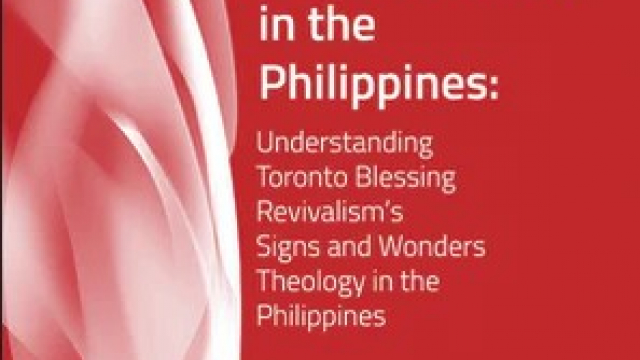Click to join the conversation with over 500,000 Pentecostal believers and scholars
Click to get our FREE MOBILE APP and stay connected
| PentecostalTheology.com



 Lora Angeline Embudo Timenia, Third Wave Pentecostalism in the Philippines: Understanding Toronto Blessing Revivalism’s Signs and Wonders Theology in the Philippines (Baguio City, Philippines: Asia Pacific Theological Seminary Press, 2020), 192 pages, ISBN 9789718942918.
Lora Angeline Embudo Timenia, Third Wave Pentecostalism in the Philippines: Understanding Toronto Blessing Revivalism’s Signs and Wonders Theology in the Philippines (Baguio City, Philippines: Asia Pacific Theological Seminary Press, 2020), 192 pages, ISBN 9789718942918.
Lora Timenia is an ordained minister with the Assemblies of God in the Philippines. She has a Master of Theology degree from Asia Pacific Theological Seminary and serves both in the administration of the school and on its faculty (biographical information on the back cover). The Publisher’s Preface of the book tells us that this volume is the publication of the author’s master’s thesis. It is thus an academic work, a quick look at the table of contents demonstrates this. There is a logical unfolding of the material presented in the book. The chapters cover things such as: reviews of relevant literature (Chapters 2, 3, 4, 5), an explanation of methodology (Chapter 6), presentation of and understanding of findings (Chapters 7 and 8) evaluations (Chapters 9 and 10), a conclusion and recommendations (Chapter 11). Though this book is very academic in format it is not difficult to read, the language employed is clear and straightforward.
“With this book, Lora Timenia provides the Pentecostal/Charismatic movement with critically-needed tools and wise counsel for evaluating unusual spiritual experiences and phenomena. Her sympathetic yet critical analysis of four influential proponents of the Toronto Blessing revivalism in the Philippines is marked by careful research, informed analysis, and a pastoral heart. Timenia’s detailed research and insightful evaluation is communicated in clear language and marked by an irenic spirit. Her ability to instruct and her desire to edify shines through on virtually every page. The result is a book that not only offers valuable counsel for the burgeoning charismatic churches of the Philippines, but one that also provides much-needed pastoral perspective for the global Pentecostal movement.” – Robert P. Menzies – From the Foreword
As was stated above Timenia is from a classical Pentecostal church, the Assemblies of God (page vii). This book was born out of her experience with, and questions about, revivalist churches that were different than her own. These “Toronto Blessing” churches emphasized signs and wonders, they accepted things like gold dust, gemstones, and angel feathers as manifestations that come from God (pages vii, 9). She wondered about the origins of this movement and their theology (page vii). She tried to research these churches in the Philippines and found that there was no academic literature about them (page viii). She decided to address this deficiency. She read material that was available about this movement, in the Philippines and from the West. She also interviewed key leaders of this movement in her own country: “Hiram Pangilinan, Apollo ‘Paul’ Yadao, Miguel Que, and Ronald De Asis Betiwan” (page viii).
The author’s motivations in writing this book are to present a sound academic understanding of Toronto Blessing revivalism, to address the confusion of classical Pentecostals in her own country about this movement, and to provide some guidance in evaluating various manifestations (page ix). She does not wish to criticize this movement in a destructive way (page xvii), though she does have some concerns about it (page 4). The main questions she seeks to answer in this study are: “What is a TB revivalist theology of signs and wonders from a Filipino perspective?” What contributed to the development of this theology in the Philippines?” “And, what are the implications of this theology in the Filipino P/C context?” (page 5). In the previous sentence “P/C” stands for Pentecostal/Charismatic. Timenia is careful to distinguish and define the various classifications of Spirit-empowered movements referred to in the book (pages 6-9).
If you live in the West, do not let the title of this book dissuade you from reading it. While the author has a decided interest in examining the Toronto Blessing movement in the context of her own country, one need not live in the Philippines in order to benefit from reading it. Timenia believes that there is a connection between the Toronto Blessing Movement in her country and in North America (page 5). Because of this, she traces the significant historical developments of the movement and its leaders (pages 23-32). In this section the reader will encounter the names of many well-known leaders in this movement, people like: John and Carol Arnott, Randy Clark, Bill Johnson, and Che Ahn. So if you are interested in the history of this movement you will find it in this book. Her research also contains a survey of relevant sources about revivalism in the Filipino context (Chapter 4). This includes material from Toronto Blessing ministers in the Philippines (pages 49-53; 56-58). Timenia notes that Pentecostal/Charismatic and Toronto Blessing Christianity is attractive to Filipinos and fits in well with their worldview (page 78). She further cites information from Filipino ministers who are part of the Toronto Blessing Movement. I found Filipino minister Hiram Pangilinan’s biblical support for gemstones to be very unconvincing (page 92). However, I found Apollo “Paul” Yadao’s ideas about how to discern what is of God to be refreshing (page 100). Miguel Que’s statements about Scripture and signs and wonders were also good (page 106). In Chapter 8 Timenia identifies common themes that she uncovered in Filipino and American Toronto Blessing Movements.
Timenia believes that there is a connection between the Toronto Blessing Movement in her country and in North America. Because of this, she traces the significant historical developments of the movement and its leaders.
What may be of particular interest to some readers is the author’s treatment of the subject of spiritual manifestations. This is a topic of great interest and concern to many in the Spirit-filled community. It is especially a concern if we cannot offer any Scripture to support the manifestations that are taking place. Timenia has developed some criteria for discerning whether a manifestation is from God. She asks four questions about unusual manifestations. The four questions are: “Does a Manifestation Have Biblical Precedent?” (page 141), “Can the Manifestation Be Used to Point to the Salvific Purposes of God? (page 142), “Does the Manifestation Glorify God, Not Humans or Other Beings?” (page 145), and “Does the Manifestation Conform to Scriptural Teachings?” (page 146). She offers information and explanations about why each of these questions is important. After setting forth these questions she takes the reader through the discernment process by applying the questions to one of the manifestations that is sometimes found in the Toronto Blessing Movement.
Spiritual manifestations … is a topic of great interest and concern to many in the Spirit-filled community.
This book is well organized, clearly written, and carefully documented. If you are interested in Christian history, Global Christianity, or Pentecostal issues or theology, then you will find valuable information in this volume.
Reviewed by John Lathrop
N. American Publisher’s page: https://wipfandstock.com/9781725294219/third-wave-pentecostalism-in-the-philippines/




Anonymous
the toronto blessing cannot be understood Peter Vandever Philip Williams
Anonymous
Troy Day I suppose you are right.
Anonymous
https://www.pentecostaltheology.com/the-toronto-blessing-what-did-we-learn/
Anonymous
More deception, false spirituality, tossing to and fro by every wind of doctrine.
Anonymous
Hopefully they will not abandon the one true Faith.